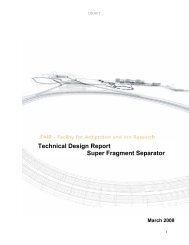1 st BASTRA meeting - GSI Webserver WWW-WIN
1 st BASTRA meeting - GSI Webserver WWW-WIN
1 st BASTRA meeting - GSI Webserver WWW-WIN
You also want an ePaper? Increase the reach of your titles
YUMPU automatically turns print PDFs into web optimized ePapers that Google loves.
EXECUTIVE SUMMARY (Short Minutes)<br />
Extract from Ved Bhatnagar’s Mission report (internal)<br />
The <strong>meeting</strong> proceeded with brief presentations of the three projects: HINDAS,<br />
n_TOF_ND_ADS and MUSE. In each case, the co-ordinators briefly outlined the<br />
objectives and scope of the work to be carried out in their projects followed by<br />
presentations made by work package leaders on the tasks that they are responsible for.<br />
Presentations were also made by 5 ISTC projects in this area including the one from<br />
Nuclear Data Centre at NEA. The aim of the discussion during and after the<br />
presentations was to highlight the issues that are of importance for nuclear data needs<br />
for an ADS and in particular the ones that are not being addressed in the presently<br />
running FP5 projects.<br />
The main points of the discussion can be summarised as follows (Partially based on<br />
the slide that Noulis Pavlopoulos presented in the discussion)<br />
• The Commission’s initiative of clu<strong>st</strong>ering of related FP5 projects and facilitating<br />
exchange of information was highly appreciated. It was more so for the <strong>BASTRA</strong><br />
clu<strong>st</strong>er as not only the FP5 projects but also the ISTC related projects and<br />
OECD/NEA participation made the <strong>meeting</strong> more valuable.<br />
• The nuclear (cross section) data bank at NEA/OECD is dealing with all kinds of<br />
cross section data, for all kinds of isotopes, in all energy ranges and for all kinds of<br />
applications. This has lead to a mammoth job which is becoming somewhat<br />
unwieldy and puts people off.<br />
• It was sugge<strong>st</strong>ed that the <strong>BASTRA</strong> clu<strong>st</strong>er focus on the specific needs of nuclear<br />
cross section data for Accelerator Driven Sy<strong>st</strong>ems for P&T. This implies<br />
reiterating (some information is already available from NEA) and li<strong>st</strong>ing the (Z,A)<br />
of the isotopes, nuclear reaction mechanisms and the energy range for which this<br />
data is required.<br />
• There is a need to review and take <strong>st</strong>ock of the situation of the data that already<br />
exi<strong>st</strong>, the data that is being acquired and planned during the present FP5 and other<br />
projects on nuclear data. This would culminate in defining properly the future<br />
needs and efforts required in this direction. A sub group is proposed to be set up to<br />
work it out and for reporting (see below).<br />
• It was sugge<strong>st</strong>ed that the input data should have to be filtered by a quality control<br />
sy<strong>st</strong>em (or criteria) before it is accepted for dissemination via the Nuclear Data for<br />
ADS (NUDADS) databank (name coined by myself!) possibly managed by<br />
NEA/OECD. The quality control parameters should be defined and may include<br />
∆E/E, precision, completeness parameters etc.<br />
• There should be more complete horizontal activities relating to interactions<br />
between authors of different theoretical models including transport codes so that<br />
they can sort out the reasons for discrepancies among different evaluations that are















